|
|
| AFRICA 2007 - Part Three
|
We landed at Shinde strip and James arrived with cold towels and soft drinks for the four minute drive to camp. Steve said he was off to western Botswana to pick up some other guests but would be back later for lunch. As we drove toward camp, he took off, buzzed our truck and gave us a wing wag.
We were greeted by Olivia – she and her husband Richard have been managers here for just over a year (January ’06). Olivia is from Dublin originally and Richard is from South Africa, but they have spent time in Australia and New Zealand as well.
I had been at Shinde camp (the name means “Ground Squirrel”) in 1999, but I can see the nice changes they made to the public spaces. We went up to the tree house dining room where they had a buffet of bobuti (and lamb/rice casserole), cucumber salad, green salad, and naan bread for lunch, with a lovely cheese tray afterwards. We met Len and Derek, two older English gents who will be leaving later in the afternoon, Sarina, a woman from South Africa traveling on her own, and two German couples, Claus and Ule, and Regina and Aghim.
|
|
They are expecting five more guests this afternoon, so we will have twelve guests in camp. After lunch, Olivia gave us the run-down on the schedules and meals: coffee or tea is brought to the tents at 6:00, breakfast up at the dining room at 6:30, activity at 7:00, lunch at 11:30, tea at 3:30, activity at 4:00, and dinner at 8:00. They have a choice for five activities in the morning: game drive, game walk, mokoro (small boats that are poled through the water), power boat or fishing. In the afternoon, they do not offer mokoros or game walks, as that is prime time for hippos and predators. She showed us to our tent - we have one of the last tents, past the swimming pool, and it looks like the tents have been redone since I was last here as well. The door is wooden, as opposed to zippers, and there is a large king-size bed, hardwood floors, fully plumbed en-suite bathroom with double sinks, shower and a separate toilet.
|
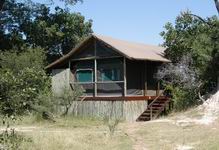
|
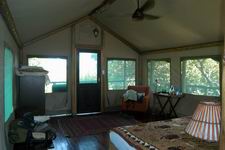
|
|
We didn’t have to be anywhere until 3:30 for tea at the fire pit, so we unpacked, stowed our gear and took naps. We went back down for tea at 3:30 and had cakes and coffee. We met the new arrivals: Leann, a tour operator from Cape Town, and her four clients (Jane, Tony, Ken and Renee) who had just come from another camp in western Botswana. We were divided up by activities and groups – Gary and I had one truck to ourselves with James, Sarina was on her own with Bee, and Julius was in charge of Leann and her group.
There was a brush fire near camp about four days before we arrived and there is quite a large area in front of camp and near the airstrip that is blackened. Despite that, new grass is already coming up.
James was the guide for Mom, Dad, Ron and Jim when they were here at Shinde camp in 2004. We headed out of camp and immediately saw a small herd of tsessebe and zebra. Tsessebe (or Topi) are medium sized antelope that live in loose herd groups, and are know for their speed – they can reach up to 70 km per hour at a dead run. They are often seen standing on small hills to get a better view. I reminded James that when my mother was at Shinde camp she would frequently ask him, “What is that animal over there?” and he would patiently answer, “It’s a tsessebe, ma’am.”
|
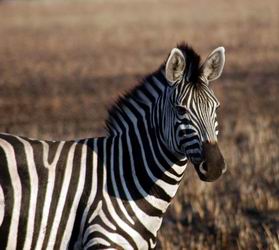
|
|
|
|
We saw several giraffe including a pair of 4-5 month olds.
|
|
One of the highlights for me was a family group of Sable antelope - an adult male, adult female and young calf. Sable are beautiful animals, the males being black and the females being chestnut to dark brown, with both sexes having long horns that arch backwards. The horns of a male Sable can reach 1 ½ meters. The calf was about 2 months old with horns that had already budded.
|
|
We looked for signs of a leopard that had been seen earlier that day, but didn’t find him. After driving for a while, however, James found five of the famous “Shinde Lions,” including “One Eye”, the old matriarch of the pride. She, along with two other mature lionesses and a juvenile lion and lioness (about 3-4 years old) were sleeping, arrayed in a circle in the grass. They were relatively unimpressed with us, but a couple took interest when Gary shifted in his seat, so we sat quietly until they went back to sleep.
|
|
On the way back we stopped for a sundowner near a hippo pond, with two crocs and a lovely sunset. James worked the spotlight on the way back: wild cat, lechwe (another type of antelope), reed buck and, of course, tsessebe.
|
|
When we got back to our tent, we found an ice bucket with a bottle of sparkling wine, glasses, and a plate of cheese and crackers waiting on our veranda, with a note from Ker and Downey wishing us many happy years together. We sat on the porch and enjoyed it before showering and heading down for dinner.
|
| 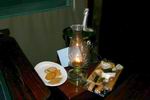
|
|
We had a drink at the fire pit, then up to dinner. Each night one of the women announces the menu (followed by applause), and then another woman announces the wines for the evening, complete with varietal and vintage (with more applause). Tonight we had asparagus au gratin to start, then schnitzel, potatoes, creamed spinach, mixed veggies and crème caramel for dessert. We had a chance to talk to Ken and Renee – they are from Calgary Canada, he’s a GP, and she’s involved in medical products of some sort. Very nice people.
After dinner we enjoyed drinks by the fire and then Julius walked us home.
Wednesday, April 25, 2007
We slept well – Gary actually got up and turned off the fan sometime in the night as it was quite chilly. This is the beginning of winter in the southern hemisphere, and while the daytime temperatures will get up into the 80s or 90s, at night it can dip down into the 30s. We had a knock on the door a few minutes before 6:00 and one of the girls brought coffee in. We dressed and went up to breakfast: fruit, yogurt, juice, eggs, bacon, sausage, toast and coffee.
A little before seven, we were back in the truck with James. We saw a few elephants – five or six bulls, including “Bigfoot”, and older bull with a leg injury (healed), and sadly, the carcass of an elephant killed by the hunting lodge next door. They had taken his tusks and feet as trophies. James found the carcass by following a big spiral of vultures and marabou storks that were circling nearby.
|
|
While I cannot personally understand why someone would rather kill an elephant than see it living, the revenue brought into the reserves by the relatively few hunting concessions helps to support the area and the country as a whole. It is estimated that a safari hunter spends 50 to 100 times the amount of an eco-tourist, and the limited number of permits allowed each year does not threaten the species that are sought.
|
|
We had some great game viewing with zebra, giraffe, impala, lechwe, tsessebe, wildebeest, warthogs, hippos, crocs, side-striped jackal, black-backed jackal, great African owl, heron and saddlebilled storks. We also saw a hyena cub – his mother had stashed him on a hill under a tree and he sat there and watched us – very cute. Well, for a hyena, that is. As someone later said, hyenas are animals that do not improve with age.
|
| 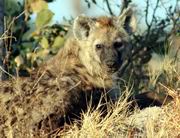
|
|
We got back to camp a little after 11:00 and rested a while before going up for lunch. Today it was grilled lamb kebabs with yogurt sauce, green salad, three bean salad, bread and some sort of fruit cobbler for dessert. Gary got his camera and took some photos of a huge variety of birds that congregate around the dining room at meal time, including a Nightjar, the bird we had seen nesting on the ground at Muchenje.
|
|
We both napped a bit after, and then went for a dip in the (cold!) pool. Aghim and Regina were there and we spoke with them for a while – they are very nice and laugh a lot. They had been planning to go to the same place we looked at in Mozambique, which was run over by a tropical cyclone, so they have had to change their plans around.
After a dip in the pool we freshened up and went back up for tea around 3:30. There was a Vervet Monkey up in the tree above the fire pit – the squirrels and bats were very unhappy, as was Richard. He said that resident monkeys can wreak havoc on a camp so he wants to discourage him from staying – and bringing friends.
|
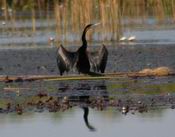
|
Leanne, Sarina, Gary and I went out on the power boat with KK in the afternoon. We saw papyrus, lovely water lilies, and lots of birds, including a darter, a type of large cormorant. Darters are often referred to as "snake birds" as they will swim in the water with just their long neck and head showing, giving them a snake-like appearance. Their plumage is somewhat permeable, and they spread their wings to dry after diving.
|
| 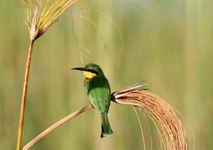
|
|
We stopped for a sundowner at a hippo pond with two hippos eyeing us across the water as the sun set. The changing colors reflected off the water were really beautiful.
|
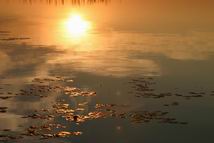
|
| 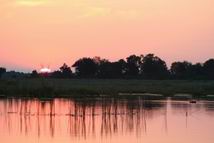
|
|
We came back, got showered and changed, then up for drinks and nibbles (mushroom toast and popcorn). The menu (applause) was: chicken liver pate (yum) to start, roast warthog (tastes like wild boar), butternut squash puree, mixed veggies and custard in phyllo cups for dessert. The wines were a 2006 Angel’s Tears Chardonnay and a 2003 Robinson Merlot, both from South Africa. The announcement tonight was followed by, “I wish you bon appetite, but not bone up a tree.”
The group that did a game drive that afternoon found a different pride of lions eating the elephant carcass that we found that morning. It was good to know that even if it was a trophy kill, the elephant's meat did not go to waste and the lions were enjoying it.
We sat next to Ken and Renee and talked with them about travel (they recommend Komodo) and hunting as Ken hunts elk and moose for meat every year. We also met Paul, the guide who runs the Footsteps camp. Footsteps is a walking safari approach – I did three days of a walking safari called “Hemingway’s” last time, and Footsteps is the current incarnation. When I did it, we would leave in the morning, walk until about 11:00 or so, turn a corner and find that the entire camp had picked up and moved to a new location. Now, Footsteps only has one camp set up and each day safaris are led out of the camp and back again. Paul will be guiding us on a drive/walk/drive safari tomorrow.
The resident genet came down to the dining room and perched on the back railing. Julius told me that her name was “Genet Jackson,” although he had a big grin on his face, so I’m not sure if that’s true. While she comes down and checks around for bits of food after dinner, Olivia said that they make sure not to feed her enough that she doesn't have to hunt for herself. Since the camp is closed for three months each year, she could starve if she became dependent on humans for her food.
|
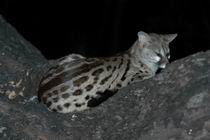
|
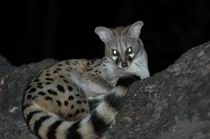
|
|
After dinner, everyone sat by the fire for a little while. We met our two new guests, Anna and Suzanna, two travel agents from London. Anna used to run a safari camp in South Africa, so knows quite a bit about the animals.
Thursday, April 26, 2007
Gary woke me at some point with something barking outside – he said it sounded like a poodle. Olivia and Richard later said it was probably a jackal, although I don’t know that the jackal would appreciate the comparison to a poodle. I went back to sleep and slept very soundly until coffee arrived at 6:00. Dressed, up to the dining room for breakfast, then Paul took us, Anna and Suzanna for our drive/walk.
We drove about an hour – stopping to see the whole family of spotted hyenas out and about: mom, dad and two cubs. Hyenas have a reputation of being scavengers, but spotted hyenas are true predators and most of what they eat is from their own kills. Their odd conformation (front legs longer than back) combined with the fact that they have a heart twice the size of an adult lion allows them to stalk their prey for many miles until it becomes exhausted. Unusual in the animal kingdom, the female hyena is larger than the male. They really blended in with the burned grass.
|
|
We stopped near a water hole, put on sunscreen and bug spray and headed out, with Paul carrying a loaded rifle at the front of the group. He showed us termite mounds and explained that they are the cooling mechanism for the termite “palace” below ground. We learned how to make a toothbrush from a red brush apple twig, how to tell male elephant from female elephant dung and how to tell male kudu from female giraffe dung (don’t ask). Paul and Anna then had a dried impala poo spitting contest (Anna won).
|
| 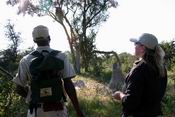
|
|
We spotted a journey of five giraffes plus two zebra stallions who watched us suspiciously for a while. We took a rest in the shade for a half hour before heading back to the truck.
|
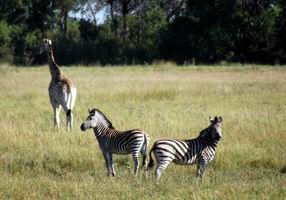
|
|
|
On the drive back, Paul stopped near some bushes where there were several types of agitated birds, all screeching about something. We stopped the truck and he said he thought it was either a snake (mamba) or a small cat. We sat for a while and didn’t see anything but when the engine started, a small cat leapt out from behind the bushes. Paul thought it was a wildcat or a genet – we tried to find him but he was too quick.
We got back to camp just in time for lunch – two types of lasagna (beef and veggie), beet salad, green salad, with a fruit salad for dessert. Ken and Renee had gone on a game drive and they found a the pride of lions near the elephant carcass but they were moving off into the bush and hard to find. After lunch Leann and her group were heading to Kanana camp, and Aghim and Regina were going to Namibia, so we said our goodbyes before heading for our siestas.
The mechanic arrived, having driven from Maun (about seven hours) to fix the generator. He’ll stay the night before heading home in the morning, assuming it’s fixed. Talk about house calls!
When we came down for tea, Roger and Dave were there – they had flown from Selinda that afternoon. It was a bumpy flight and Diana wasn’t feeling well so she was going to take it easy while the guys went on a drive with Julius. Anna and Suzanna were going fishing with Paul and we went on a drive with Sarina and Bee.
I discovered that Bee had been at Pom Pom camp (another K&D camp) when I was there. He said that Korbis and Marsha (the managers) had retired back to South Africa, and he had transferred to Shinde after K&D‘s concession at Pom Pom expired.
|
|
We saw lots of birds and decided to head out to the elephant carcass to see if we could find the lions. On the way there, Julius radioed to let us know that he found One Eye and her group in the opposite direction. We took a vote and decided to go for the sure thing, so turned around and headed back. We came through a copse of trees and found a nice herd of zebra that allowed us to get pretty close.
|
| 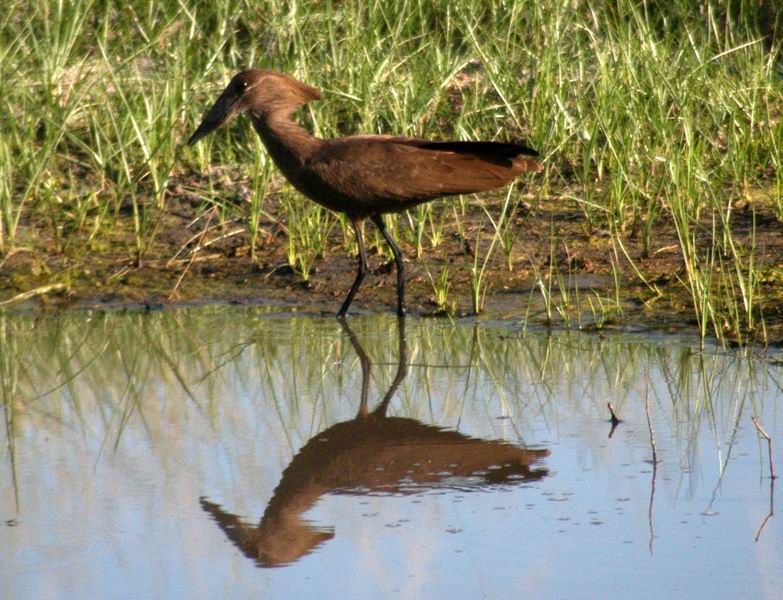
|
|
Just past the trees we found the lions, all sleeping in the shade. We watched them for a bit, and then drove for a ways to have our sundowner before coming back to the pride. By then it was dark, and the lions were up and stalking the zebra herd.
|
| 
|
|
We saw one of the lions lying down to the left of the herd, and two others moving toward the right. One of them stopped and went back to the left and a short time later I saw the young male lion coming up behind our truck. I think he might have been eyeing us as “Plan B” if the zebra didn’t work out. After a bit of tension, they were spotted by an impala who screamed, the zebra took off and it was all over. We decided to head back before the lions decided to pursue Plan B.
|

|
Bee used the spotlight on the return and we saw a few reedbucks, an owl and a wild cat on the way. We showered and changed and when we went down to the fire pit, Olivia told us we had a 7:30 a.m. flight to Selinda! She said she’s never had a flight go so early, but we speculated that Selinda must have guests on the 10:00 a.m. flight from Maun to Joburg.
|
|
Diana was there and feeling better. She said we would love Selinda camp, and said, “When you walk into your room, think of us here.”
I spoke to Olivia for a while. She said that there are certain things that they really missed being out in the bush – espresso, cider, chocolate, ice cream and prawns - so when they return to Maun for their breaks every few months they spend the first day satisfying those cravings. Sometimes Pilot Steve will bring her chocolate from Maun.
Dinner was a cold avocado soup, Moroccan fish, couscous, mixed veggies and broccoli with cheese. Dessert was lemon meringue pie – Gary said it tasted more like key lime, with a graham cracker crust. After dinner we all sat around and tried to remember group names for animals: a journey of giraffes, a leap of leopards, a coalition of cheetah, an exaltation of larks, a murder of crows. Genet Jackson came to visit again and perched behind the seats for a long time, waiting for us to leave.
Richard then gave an explanation of the lighted wall art in the dining room. It was designed by an artist who came out to see it installed. It was his “vision” of the Delta, a tableau featuring a “running storm” complete with lightning, a hunting leopard, and a waterbuck. The opposite side shows the leopard after its successful kill. He was a bit deflated when Julius referred to the waterbuck as “a cow.”
There was much laughing and we adjourned to the fire pit for some Amarula, which is a South African cream liqueur made from the fruit of the Marula tree. It tastes a bit like Bailey's Irish Cream and it is quite yummy.
Friday, April 27, 1007
Up at 6:00, dressed and finished packing. We heard hippos moving around and huffing but couldn’t see them. We had breakfast and said goodbye to everyone going out on their activities. Paul gave me a note to give to Zane, the manager at Selinda. We saw the mechanic leave, so I guess the generator is fixed.
We drove to the airstrip and James dropped us off before going to chase the baboons off the runway. Richard and several of the camp staff came with a tractor as the inbound plane was bringing supplies to camp. When the place landed, they all bustled around and unloaded it and put our bags in. We said our goodbyes to the Shinde staff and met Paul the pilot – born in New Zealand, raised in Tustin, CA (he went to Foothill High School), and now a bush pilot living in Maun. Small world.
It was a quick, smooth flight – twenty minutes – with Gary flying shotgun this time. We could see many of the places we drove at Shinde.
|
 |
|
| |